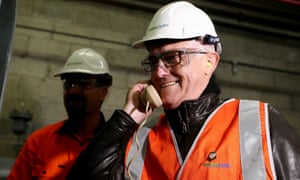Extract from The Guardian
Snowy Hydro board approves expansion of scheme to add 2,000MW of new generation capacity
More than 12 months after he first flagged it, the board of Snowy
Hydro has ticked-off on the former prime minister Malcolm Turnbull’s
“Snowy 2.0” pet project – approving the expansion of the iconic scheme to add 2,000MW of new generation capacity.
In a statement issued on Wednesday night, the board confirmed a final investment decision to proceed, subject to shareholder approval, which means approval from Turnbull’s successor, Scott Morrison.
“After almost two years of rigorous due diligence on every aspect of the project, including detailed financial analysis and ongoing geotechnical drilling, the board is confident Snowy 2.0 is a strong investment for the company,” the company statement said.
Just over a year ago, Turnbull unveiled plans for a $2bn expansion of
the Snowy Hydro scheme that could add up to 50% to its capacity. A
range of experts pointed out subsequently that the $2bn estimate failed
to take into account the construction of additional infrastructure, like
poles and wires, to transmit the power – which could add another $2bn
to the cost of the project.In a statement issued on Wednesday night, the board confirmed a final investment decision to proceed, subject to shareholder approval, which means approval from Turnbull’s successor, Scott Morrison.
“After almost two years of rigorous due diligence on every aspect of the project, including detailed financial analysis and ongoing geotechnical drilling, the board is confident Snowy 2.0 is a strong investment for the company,” the company statement said.
This time last month, the energy minister, Angus Taylor, weighed in in support of the project, at least in principle. Taylor’s grandfather was the chief engineer and commissioner for the original postwar Snowy project.
The Snowy Mountains hydro scheme was built between 1949 and 1974 and cost $820m. It is made up of 16 dams, seven power stations and 225km of tunnels. More than 100,000 people from 30 countries worked on the project, which was seen as a nation-building exercise in the postwar era.
Taylor said the Snowy’s place in Australia’s energy mix would become more important as intermittent generation became more a feature of the electricity system, because the scheme “has unrivalled capacity to store power when it is not needed, and generate it when it is needed”.
“While gas and batteries both have an important role to play, pumped hydro provides relatively low-cost storage and can run for extended time frames to match volatile supply with volatile demand,” Taylor said in a speech in November.
“Put simply, we need to effectively firm that generation, providing a solution for when the sun isn’t shining and the wind isn’t blowing, and that will matter most when we face solar and wind droughts.”
He said pumped hydro was superior to batteries “because they can’t store enough power at a sensible cost” and gas cannot store power at all.
After the board decision on Wednesday night, Taylor said the government would now assess the project on its merits.
“I’m not going to pre-empt that process. As we’ve always said, the Snowy 2.0 needs to stack up”.
The government is expected to make its position known before Christmas but Taylor’s statement on Wednesday night was more hedged.
“We will take whatever time is required to do the necessary due diligence and go through our usual processes to ensure we make the right decision,” he said.

No comments:
Post a Comment